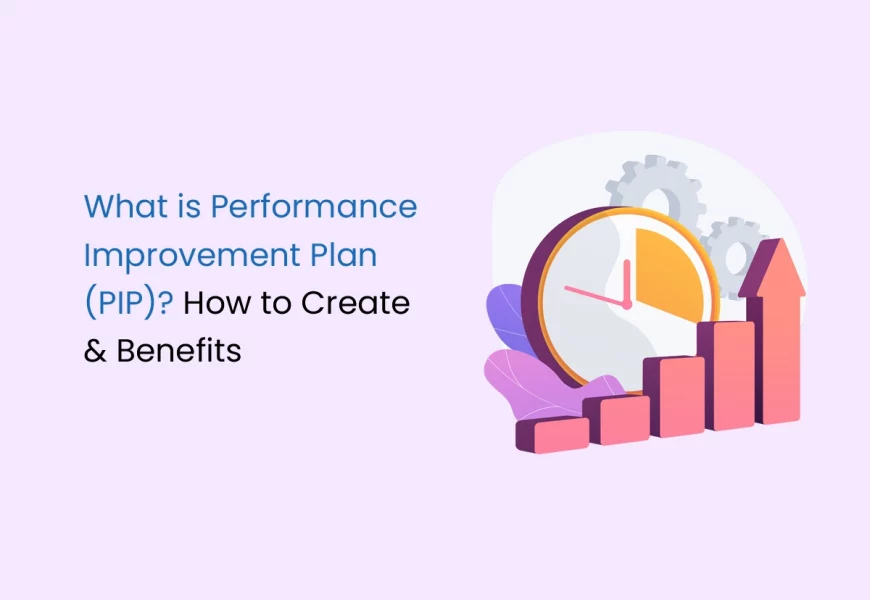In corporate when an employee gets a poor performance review, management can offer them a final opportunity to improve their performance through a Performance Improvement Plan (PIP), which is sometimes referred to as a Performance Action Plan.
A PIP outlines clear objectives that the employee must achieve in order to avoid dismissal, demotion, or transfer. Establishing these specific goals allows the employee to enhance their performance and align their contributions with the expectations of the organisation.
In this article, we should be discussing everything you know about a PIP- how to design one, pros and cons, tips, and much more.
What is a Performance Improvement Plan (PIP)?
A Performance Improvement Plan (PIP) is a structured document designed to help employees address areas of underperformance while outlining clear steps for improvement. It typically covers specific job-related skills, such as technical tasks, or soft skills, like communication and leadership, where the employee may be lacking. The PIP is usually drafted by the employee’s supervisor, with input from HR, and includes a timeline for progress. In cases where an employee aims for a promotion, a PIP can also be a roadmap for further development, fostering growth towards more advanced roles.
The plan contains clear objectives, deadlines, and measurable goals, ensuring the employee has a fair opportunity to improve. It emphasises transparency in communication and often highlights any potential consequences if improvement isn’t made within the set time. Supervisors also play an ongoing role during the PIP process, offering guidance, feedback, and necessary resources. In short, a PIP is not just a corrective tool but a collaborative effort aimed at either salvaging a struggling employee’s career or setting the stage for their next step.
Benefits of a Performance Improvement Plan (PIP)
PIPs can be super beneficial for a company. Here is how:
Helps to Spread a Positive Company Culture
A Performance Improvement Plan (PIP) fosters a supportive and growth-oriented work environment. Employees are more likely to thrive when their expectations are clearly defined, and accountability is encouraged. By focusing on constructive improvement rather than dwelling on shortcomings, a PIP reinforces a culture of positive development, where employees know they can receive guidance when needed. This approach reduces defensiveness and creates an atmosphere of support, reinforcing that the organisation is invested in their growth.
Makes Employees Feel Supported
When managers invest time and effort in drafting a PIP, it sends a clear message to employees: their progress and well-being matter to the company. By providing detailed feedback and clear steps for improvement or advancement, the PIP shows that managers are committed to guiding employees, rather than leaving them to navigate challenges alone. This personalised approach boosts employee morale and fosters a sense of care and support.
Saves Resources
Replacing an employee can be both time-consuming and costly. Recruitment, training, and onboarding require significant resources, making retention of existing staff more cost-effective. When an employee shows potential—particularly in soft skills like communication, patience, and teamwork—investing in their development through a PIP can be a far more efficient solution. Rather than terminating an underperforming worker, providing the opportunity to improve not only saves resources but also retains valuable talent that can adapt with the right guidance.
A well-executed PIP not only benefits the individual but enhances the organisation’s overall productivity while also contributing to a more cohesive and positive company culture.
Disadvantages of a Performance Improvement Plan (PIP)
PIPs Should Have Meaningful Conversations
Handing over a performance improvement plan (PIP) to an employee is only the first step. Meaningful conversations must follow, where the manager addresses concerns, clarifies expectations, and answers any questions. However, even with a positive tone, these discussions can be difficult for both parties. Feedback, no matter how constructive, is often hard to give and receive, making the conversation a delicate matter that requires tact and empathy.
Performance Improvement Plans Require Significant Time Investment
Creating a comprehensive PIP demands a considerable amount of the manager’s time. From drafting the document to holding discussions with the employee, the process is resource-intensive. Follow-up evaluations, feedback sessions, and monitoring progress add to the time commitment, requiring consistent engagement to ensure success.
Potential for Misinterpretation
Even with the best intentions, there is a possibility that an employee may misinterpret the purpose of the PIP. Whether designed to help an employee improve or provide a pathway for advancement, a PIP can sometimes be perceived as a precursor to termination. This underscores the importance of clear communication, where the manager must take care to explain the rationale behind the PIP to avoid unnecessary misunderstandings. Clear, ongoing dialogue can help alleviate such concerns and keep the focus on development and progress.
How to Create a Performance Improvement Plan (PIP)?
Creating a performance improvement plan (PIP) need not be overly complex. Start by assessing whether a PIP is the most appropriate strategy for your business and employee. Once determined, structure the plan clearly, outlining the areas of concern and setting achievable goals. Arrange a meeting with the employee to discuss the plan, ensuring they understand its purpose and objectives. Provide them with a timeframe for improvement, typically ranging from 30 to 120 days, depending on the role, and regularly monitor their progress throughout this period. Open communication is key during the process to support their growth and development.
Assessing Whether a PIP Is Suitable
Before implementing a Performance Improvement Plan (PIP), it’s essential to determine if it’s the right solution. For severe cases, such as an employee creating a toxic environment, termination might be more appropriate. On the contrary, minor issues might only require an informal discussion to resolve.
Developing a Structured Plan
Once you’ve identified the need for a PIP, it’s crucial to carefully outline what it should entail. A manager must consider what success looks like for the employee, how they might perceive the PIP, and how it will be executed. It’s advisable to consult with HR for guidance, using their expertise and available templates to construct a meaningful plan. HR can help track the employee’s progress and maintain records for accountability and consistency. Regular assessments and open dialogue with the employee are also critical in ensuring the plan is executed effectively and fairly.
By taking these thoughtful steps, the PIP will become a tool for constructive improvement rather than simply a corrective measure, ensuring both the employee and the business can thrive.
Engage in Meaningful Dialogue with the Employee
A successful Performance Improvement Plan (PIP) begins with an open conversation between the manager, the employee in question, and, when necessary, a representative from HR. Without this dialogue, employees may misinterpret the intent of the PIP or harbour misconceptions about their performance expectations. By discussing the specific improvements outlined in the plan, managers can provide valuable context, clarify any uncertainties, and foster a collaborative environment that encourages employee engagement.
Monitor Employee Progress Closely
Accountability is crucial for the effectiveness of a performance improvement plan. If the outlined improvements and their corresponding consequences are not monitored consistently, the PIP loses its significance and may lead employees to underestimate its importance. Typically, progress is evaluated at regular milestones—such as 30, 60, and 90 days—tailored to the role in question. This timeframe should allow for realistic improvements, as businesses generally anticipate noticeable changes within 90 to 120 days. If progress is not achieved within this period, it may indicate that further performance enhancements are unlikely.
Assess Employee Performance After the PIP Period
Should an employee fail to meet the expectations set forth in the PIP, the manager must determine the appropriate next steps. It is beneficial for the PIP to outline a range of potential consequences, providing flexibility based on the circumstances. Ultimately, the decision on how to proceed should involve the manager, potentially in consultation with HR, to evaluate whether it is worthwhile to continue investing time and resources into the employee’s development.
Designing a PIP
Each performance improvement plan needs to be customised as per the employee’s and the employer’s needs. This goes without saying, as no two employees will have the same problem areas. This is a short guide that will help you design the perfect PIP:
Conduct Comprehensive Manager Reviews
Employee success is fundamentally a team effort. If individuals have not received the necessary support, training, and ongoing guidance from their managers or supervisors, they cannot be expected to thrive in their roles. It is essential to evaluate the employee’s training history, onboarding experience, and the level of support provided by their manager or supervisor. This assessment will help identify whether a lack of training or assistance from leadership has contributed to the employee’s performance challenges.
Furthermore, it is important to understand the expectations and goals set by the employee’s supervisor. Are they genuinely committed to helping the employee succeed, or are they primarily focused on pursuing termination? The mindset of the supervisor can significantly influence the effectiveness of the Performance Improvement Plan (PIP) and the overall outcome for the employee. This situation should not be framed as an adversarial relationship between employee and employer; rather, it is crucial for everyone involved to work collaboratively from the outset, aligning their efforts as a cohesive team.
Initiate the PIP with a Structured Template
With the gathered information, the employee’s manager or supervisor can begin drafting the performance improvement plan. This draft should then be submitted for review by the HR department to ensure it meets all necessary criteria. The PIP document should encompass several key components, including:
- Background and Basics:
- The employee’s name, title, job description, and primary responsibilities.
- Clear expectations regarding the employee’s performance levels, such as sales targets or project deliverables.
- A detailed record of deficiencies, including specific examples, dates, and supporting evidence.
- Clear Goals and Timelines:
- A well-defined timeline that includes scheduled check-in meetings to monitor progress.
- Attainable goals established within a realistic timeframe, such as:
- Achieving a specific sales target within one quarter.
- Ensuring no late arrivals or unapproved absences over the course of a month.
- Meeting all project deadlines consistently for three months.
- Completing tasks at an agreed-upon rate.
- Support Mechanisms:
- A description of how the company will assist the employee in achieving these goals, which may include access to training courses, mentorship opportunities, or coaching sessions.
- Clearly outlined consequences for failing to meet the objectives of the plan or for not completing it as required.
Facilitate an HR Review
Following the initial drafting of the PIP, the HR department should conduct a thorough review of the document and the supporting evidence. This review is essential to ensure that all claims are substantiated and appropriate for a PIP. HR should confirm several critical aspects, including:
- The goals set forth in the PIP are not only attainable but also relevant and feasible within the specified timeframe.
- There is no indication of bias against the employee from their manager. If a supervisor appears more inclined to terminate an employee than to assist them through a PIP, the documentation may disproportionately emphasise the employee’s shortcomings.
- The employee has access to the necessary tools, resources, and guidance required to achieve the goals outlined in the plan successfully.
Conduct the PIP Meeting
Following the approval of the Performance Improvement Plan (PIP) by the HR team, the next step is to convene a meeting involving the manager, an HR representative, and the employee. This meeting is a crucial opportunity to review the plan and the established timelines collaboratively.
It is essential to cultivate an open and positive atmosphere during this meeting. Emphasise that the primary aim is to encourage and support the employee, helping them realise their full potential. A supportive environment fosters trust and engagement, making it easier for the employee to express their thoughts and concerns.
Encouraging the employee’s input and feedback is vital for nurturing a constructive dialogue. Allow them to ask questions and voice any blockers or challenges they may be facing. By actively listening and addressing these concerns, you can work together to find practical solutions and enhance the employee’s commitment to the improvement process.
After the meeting, be prepared to modify the plan based on the employee’s input, where appropriate. Flexibility can demonstrate your commitment to their development and show that their perspective is valued. Once the final plan is agreed upon, it must be signed by both the manager and the employee and subsequently approved by HR to ensure all parties are aligned.
Implement Employee Check-Ins
Once the employee has received the performance improvement plan and the agreed start date has arrived, the responsibility for progress largely shifts to them. Typically, a PIP lasts for 30, 60, or 90 days, depending on the specific goals set for the employee and the timeframe required to achieve those objectives.
To ensure a smooth process throughout the duration of the plan, it is important to schedule regular check-in meetings between the manager and the employee. These meetings provide a platform for ongoing support and guidance, enabling the employee to maximise their learning and development during this period.
During these check-ins, double-check that the employee has access to all the necessary tools, resources, and training required to succeed. Maintaining open lines of communication is crucial, as it allows the employee to seek advice or assistance should they encounter any difficulties along the way.
Conclude with Plan Completion and Next Steps
At the conclusion of the performance improvement plan, arrange a closing meeting with the employee and their manager to review the progress made. This meeting serves as an important opportunity to evaluate which goals the employee has achieved and to clarify the next steps moving forward.
If the employee successfully meets their goals or completes their training before the official end of the plan, consider advancing this meeting to celebrate their accomplishments sooner. Regardless of the timing, this meeting is an excellent opportunity to recognise the employee’s hard work and dedication, reinforcing positive behaviour and outcomes.
During this discussion, set clear expectations for the employee’s job performance in the future and emphasise the importance of maintaining momentum. By celebrating their achievements and outlining the path ahead, you can foster a continued sense of motivation and engagement, ensuring the employee feels valued within the organisation.
Tips to Create a Successful Performance Improvement Plan
There are several crucial factors that can significantly influence the success of an effective Performance Improvement Plan (PIP) process.
- Identify the Root Cause of the Issue: Begin by delving into the underlying factors that may be impacting the employee’s performance. It is important to analyse their work habits, skills, and overall work environment to pinpoint what might be holding them back. By taking the time to investigate these elements thoroughly, you can build a targeted plan that directly addresses the identified issues. This approach not only helps craft a more effective PIP but also demonstrates a commitment to the employees’ development.
- Involve the Employee in the Process: Engaging the employee in the development of their PIP is vital for fostering collaboration and ensuring mutual understanding. By involving them in the planning process, you can ensure they have a clear grasp of their goals, responsibilities, and expectations for improvement. Their active participation encourages a sense of ownership over their progress, making them more likely to commit to the plan and strive for success.
- Set Clear and Measurable Goals: It is essential to establish specific, attainable, relevant, and time-bound (SMART) goals that are clearly defined and comprehensible to all parties involved. Any discussions regarding the employee’s PIP should revolve around these goals. By setting clear expectations, you create a structured framework that guides the employee and allows them to focus their efforts on achieving the defined outcomes.
- Provide Regular Feedback and Coaching: Ongoing communication is a critical component of effective feedback. Managers should be trained to offer constructive feedback regularly, providing employees with insights into their performance and progress. This feedback should be objective and transparent, enabling employees to understand how they are doing in relation to their goals. Regular check-ins and coaching sessions can help keep the lines of communication open, allowing employees to seek clarification or support when needed.
- Document Progress and Outcomes: It is imperative for HR managers to maintain detailed records of the employee’s progress throughout the PIP process. This documentation serves multiple purposes; it not only helps in evaluating the effectiveness of the plan but also provides a comprehensive overview of the employee’s journey towards improvement. Should any adjustments be necessary, having a well-documented record can facilitate informed decision-making.
- Reward Success Along the Way: Recognising and rewarding achievements throughout the PIP can significantly enhance motivation. Positive reinforcement can encourage employees to continue making progress and to sustain their improved performance. Celebrating milestones, no matter how small, reinforces the idea that their efforts are valued and appreciated, which can further inspire them to excel in their roles.
Examples of Performance Improvement Plan
Here are some examples that give you a sample plan for different situations at work:
Example 1: Addressing Poor Attendance
Performance Issue: The employee in question has exhibited a consistent pattern of absenteeism, which has resulted in numerous missed workdays and disruptions to the overall workflow of the team. This pattern not only affects the individual’s performance but also impacts the productivity and morale of their colleagues.
Main Goal: The primary objective is to reduce the employee’s absenteeism to an acceptable level, ideally maintaining it below 5% of their scheduled workdays. Achieving this goal is vital for restoring balance within the team and ensuring that projects are completed on time.
Measurable Key Performance Indicators (KPIs): To effectively monitor progress towards this goal, the following measurable KPIs should be established:
- Absenteeism Rate: Track the percentage of scheduled workdays that the employee is absent. This metric will provide a clear indication of any patterns in attendance and highlight areas needing improvement.
- On-Time Project Completion Rate: Monitor the percentage of projects completed by the employee within the agreed-upon deadlines. This KPI will help assess the impact of absenteeism on the employee’s ability to meet work commitments.
Action Plan: To address the issue of poor attendance, the following steps should be taken:
- Initial Meeting: Schedule a meeting with the employee to discuss their attendance issues openly. This conversation should aim to explore the underlying reasons for their absences, allowing the employee to express any concerns they may have.
- Clear Expectations: Provide the employee with clear expectations regarding their attendance. It is important to outline the potential consequences of continued absenteeism, ensuring that they understand the seriousness of the situation.
- Develop Strategies: Collaborate with the employee to develop strategies that address the potential causes of their absences. This may include offering flexible work arrangements to accommodate personal circumstances or addressing any health concerns that may be affecting their ability to attend work regularly.
- Attendance Tracking: Implement mechanisms for tracking attendance effectively. This could involve regular check-ins to monitor progress and provide ongoing support as needed. Maintaining open lines of communication is essential for addressing any further issues promptly.
- Communication Training: Provide training on effective communication practices to ensure the employee understands the importance of notifying management about absences in a timely manner. This training can equip them with the skills needed to keep their manager informed about their situation and progress.
Example 2: Addressing the Issue of Not Meeting Deadlines
Performance Issue: The employee has been consistently failing to meet deadlines for assigned tasks and projects. This persistent issue is causing significant delays and disruptions within the team, impacting overall productivity and the successful completion of projects.
Main Goal: The primary objective is to ensure that the employee consistently meets deadlines for all assigned tasks and projects. Achieving this goal is crucial for maintaining the team’s workflow and ensuring that project timelines are respected.
Measurable Key Performance Indicators (KPIs): To effectively assess progress towards this goal, the following measurable KPIs should be established:
- On-Time Project Completion Rate: Monitor the percentage of projects completed by the employee within the agreed-upon deadlines. This metric will provide a clear indication of the employee’s ability to deliver work on time.
- Task Completion Rate: Track the percentage of tasks that the employee completes within the specified timeframe. This KPI will help identify any patterns of behaviour related to time management and task execution.
- Action Plan: To tackle the issue of not meeting deadlines, the following action plan should be implemented:
- Time Management Assessment: Begin by conducting a comprehensive assessment of the employee’s time management skills to identify specific areas where improvement is needed. This assessment will help highlight any obstacles the employee may be facing.
- Training on Time Management Techniques: Provide targeted training on effective time management strategies. This training should cover techniques such as prioritisation, task decomposition, and the use of scheduling tools to enhance the employee’s ability to manage their workload effectively.
- Project Tracking System: Implement a systematic approach for tracking project progress and deadlines. This could involve using project management software that allows both the employee and their supervisor to monitor the status of tasks in real-time.
- Encourage Regular Communication: Foster an environment of open communication regarding project status and any potential challenges the employee may be facing. Regular check-ins with the supervisor will help address issues promptly and provide support when needed.
- Establish Clear Expectations: Clearly outline the expectations for deadlines, including the consequences for failing to meet them. This transparency will help the employee understand the importance of adhering to timelines and the impact of their work on the team.
FAQs on PIP
Does a PIP lead to termination?
No, a PIP does not automatically result in termination. However, if an employee fails to meet the performance goals outlined in the PIP, the employer reserves the right to terminate their employment in accordance with the notice period specified in the contract.
Does a PIP affect salary?
If you successfully complete the PIP, you will be able to continue your employment with the organisation. Conversely, if you do not meet the required objectives, the one-month duration of the PIP may be considered part of your notice period, with the remaining two months' salary being paid to you accordingly.
Can I resign while on a PIP?
It is generally advisable to resign voluntarily rather than wait for your employer to terminate your employment at the end of the PIP. Yes, you can resign during this period, and any salary that is on hold will eventually be paid out to you.
Is a PIP mentioned in a relieving letter?
Typically, a PIP or similar performance-related issues are not included in relieving or experience letters. Therefore, if you fail a PIP, it should not impact the content of your experience letter.





















